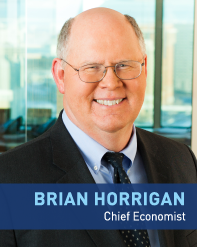Almost nothing has felt certain in 2020. The presidential and congressional election results are two more things to add to the list. Markets had largely expected a blue wave, which has not materialized. Votes in key states are still being tallied and legal challenges look like a given at this point. We expect heightened volatility as this waiting game plays out and developments unfold.
But from an economic perspective, we have argued before that it may not matter much who is in office; in practice, the US political process tends to moderate policies at either end of the political spectrum. We believe the credit cycle will continue progressing through credit repair and toward a full recovery, no matter who is in the White House. The latest wave of the COVID-19 pandemic is a challenge, to be sure. But as we look through nearer-term instability from the election and the pandemic, these are some of the things that give us confidence in the economic recovery.
|
Fiscal Support: Regardless of which party controls the White House and Congress, we believe they will deliver a fiscal package. At this stage, a Q1 2021 fiscal package is our base case, but the size and composition will largely depend on the outcome of the elections. Moreover, in light of recent evidence that the recovery is slowing and the pandemic is getting worse, it is plausible, but by no means certain, that the current “lame-duck” Congress could look to pass a small fiscal package in December as a bridge to the larger fiscal package we expect in the first quarter. |
|
|
Consumer Strength: In the meantime, we believe consumers have the ability to keep the economy moving forward even with challenges like delayed stimulus and potential for more serious lockdowns. Data from before the pandemic indicated the consumer, in the aggregate, was not financially burdened. The consumer deleveraging cycle had ended,[i] and consumer spending was rising[ii] with job growth[iii] and wage acceleration.[iv] Rising household wealth[v] was also a supporting factor. The debt burden was notably low[vi] and now current savings rates are at decade highs.[vii] We think those factors are still relevant because they can serve as a foundation for a strong recovery. Our assessment would be very different if consumers had been heavily leveraged going into the crisis. One reason for the sluggish recovery after 2007-2009 was that the consumer and housing market were overleveraged. Not this time. This perspective is not meant to diminish the financial hardships many households are experiencing as a result of the pandemic. We acknowledge that many measures of consumer financial health do not account for distribution; within the consumer sector, some are heavily burdened and some are not burdened at all. However, in aggregate, we think US consumers are currently positioned to help fuel growth and recovery.
|
|
| Monetary Policy Support: The Federal Reserve (Fed) is facing a triple threat: (1) the election may take a while to work out and could be contested, leaving people uncertain; (2) depending on the eventual outcome, markets will have to process the potential policy changes the next two years could bring; (3) the latest wave of the pandemic may restrict economic activity in parts of the US as it has in Europe. We anticipate relatively sluggish growth in Q4 2020 and Q1 2021. But we believe markets have faith that the central bank will continue to provide a backstop. The Fed may be watching for financial market volatility, serious risk-off pricing, and a money market freeze-up, as happened last March. But the Fed showed last spring that it is willing to step up big and quickly in times of market stress. Monetary policy support could again help bridge the gap and smooth market volatility as we await fiscal stimulus. We believe the Fed will state that it is ready and willing to supply the liquidity that markets may need to function smoothly when it meets this week. |
Looking longer term
Election Day is over. The road to a final result probably won’t be short or straight, but the heightened uncertainty of the election will eventually fade. With the latest wave of the COVID-19 pandemic upon us, we expect some bumps as countries reinstate restrictions. But further out, our economic view is more positive. We and consensus believe a vaccine is likely by spring 2021, though full-scale production and distribution could take a while and people will need confidence that the vaccine is safe before they take it. In our view, this is a critical underpinning; we believe markets can look through this wave if it seems like social distancing measures can begin to ease in the spring or early summer of 2021.
In the meantime, if the virus or any lingering election issues feed a risk-off environment, it could potentially be a good buying opportunity.
WRITTEN BY:
[i] Source: https://www.newyorkfed.org/microeconomics/hhdc.html
[ii] Source: https://fred.stlouisfed.org/series/PCE
[iii] Source: https://data.bls.gov/pdq/SurveyOutputServlet
[iv] Source: https://www.frbatlanta.org/chcs/wage-growth-tracker
[v] Source: https://fred.stlouisfed.org/series/TNWBSHNO
[vi] Source: https://fred.stlouisfed.org/series/TDSP
[vii] Source: https://fred.stlouisfed.org/series/PSAVERT
MALR026350
There is no assurance that developments will transpire as forecasted and actual results will be different. Information, including that obtained from outside sources, is believed to be correct, but Loomis Sayles cannot guarantee its accuracy. Market conditions are extremely fluid and change frequently.
This is not an offer of, or a solicitation of an offer for, any investment strategy or product. Any investment that has the possibility for profits also has the possibility of losses.
Market conditions are extremely fluid and change frequently.
This blog post is provided for informational purposes only and should not be construed as investment advice. Any opinions or forecasts contained herein reflect the
subjective judgments and assumptions of the authors only and do not necessarily reflect the views of Loomis, Sayles & Company, L.P. Information, including
that obtained from outside sources, is believed to be correct, but Loomis Sayles cannot guarantee its accuracy. This material cannot be copied, reproduced or
redistributed without authorization. This information is subject to change at any time without notice.






